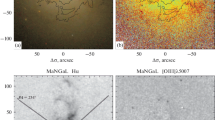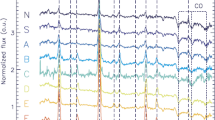Abstract
The parameters of the ionized gas in NGC 6946 (in the [NII] λλ6548, 6583, H α and [SII] λλ6717, 6731 lines) are investigated with the SAO RAS BTA telescope along three positions of the long slit of the SCORPIO focal reducer, passing through a number of large and small cavities of the gaseous disc of the galaxy. These cavities correspond exactly to the cavities in warm dust, visible at 5 − 8µm. We found that everywhere in the direction of NGC 6946 the lines of ionized gas are decomposed into two Gaussians, one of which shows almost constant [SII]/H α and [NII]/H α ratios, as well as an almost constant radial velocity within the measurement errors (about −35… − 50 km/s). This component is in fact the foreground radiation from the diffuse ionized gas of our Galaxy, which is not surprising, given the low (12°) latitude of NGC 6946; a similar component is also present in the emission of neutral hydrogen. The analysis of the component of ionized gas, occurring inNGC 6946, has revealed that it shows signs of shock excitation in the cavities of the gaseous disc of the galaxy. This shock excitation is as well typical for the extraplanar diffuse ionized gas (EDIG), observed in a number of spiral galaxies at their high Z-coordinates. This can most likely be explained by low density of the gas in the NGC 6946 disc (with the usual photoionization) inside the cavities, due to what we see the spectral features of the EDIG gas of NGC 6946, projected onto them, and located outside the plane of the galaxy. In the absence of separation of ionized gas into two components by radial velocities, there is an increasing contribution to the integral line parameters by the EDIG of our Galaxy when the gas density in NGC 6946 decreases, which explains some strange results, obtained in the previous studies. Themorphology of warmdust, visible in the infrared range and HI is almost the same (except for the peripheral parts of the galaxy, where there are no sources of dust heating).Moreover, the shock excitation of the ionized gas is detected in the smallest holes, distinguishable only in the IR images.
Similar content being viewed by others
References
R. Boomsma, Thesis, http://dissertations.ub.rug.nl/faculties/science/2007/r.boomsma/
R. Boomsma et al., Astronom. and Astrophys. 490, 555 (2008).
I. Bagetakos, E. Brinks, F. Walter, et al., Astronom. J. 141, 23 (2011).
D. R. Weisz, E. V. Skillman, J. M. Cannon, et al., Astrophys. J. 704, 1538 (2009).
G. Tenorio-Tagle and P. Bodenheimer, ARA and A 26, 145 (1988).
Yu. N. Efremov, Astronom. and Astrophys. T 21, 251 (2002).
K. Bekki and M. Chiba, Astrophys. J. 637, (2006).
S. Larsen, Yu. N. Efremov, B. G. Elmegreen, et al., Astrophys. J. 567, 896 (2002).
Yu. N. Efremov, S. A. Pustilnik, A. Y. Kniazev, et al., Astronom. and Astrophys. 389, 855 (2002).
Yu. N. Efremov, V. L. Afanasiev, E. J. Alfaro, et al., Monthly Notices Roy. Astronom. Soc. 382, 481 (2007).
M. Carmen Sánchez Gil, E. J. Alfaro, and E. Pérez, Astrophys. J. 702, 141 (2009).
N. M. McClure-Griffiths, A. Ford, D. J. Pisano, et al., Astrophys. J. 638, 196 (2006).
V. L. Afanasiev and A. V. Moiseev, Pis’ma Astronom. Zh. 31, 214 (2005).
F. Bonnarel et al., Astronom. and Astrophys. 189, 59 (1988).
A. D. Chernin, Yu. N. Efremov, and P. A. Voinovich, Monthly Notices Roy. Astronom. Soc. 275, 313 (1995).
A. Moiseev, I. Karachentsev, and S. Kaisin, Monthly Notices Roy. Astronom. Soc. 403, 1849 (2010).
L. M. Haffner, R. J. Reynolds, S. L. Tufte, et al., Astrophys. J. Suppl. 149, 405 (2003).
J. A. Collins and R. J. Rand, Astrophys. J. 551, 57 (2001).
S. Silich, T. Lozinskaya, A. Moiseev, et al., Astronom. and Astrophys. 448, 123 (2006).
Author information
Authors and Affiliations
Additional information
Original Russian Text © Yu.N. Efremov, V.L. Afanasiev, O.V. Egorov, 2011, published in Astrofizicheskii Byulleten, 2011, Vol. 66, No. 3, pp. 327–343.
Rights and permissions
About this article
Cite this article
Efremov, Y.N., Afanasiev, V.L. & Egorov, O.V. Ionized gas characteristics in the cavities of the gas and dust disc of the spiral galaxy NGC 6946. Astrophys. Bull. 66, 304–319 (2011). https://doi.org/10.1134/S1990341311030035
Received:
Accepted:
Published:
Issue Date:
DOI: https://doi.org/10.1134/S1990341311030035




